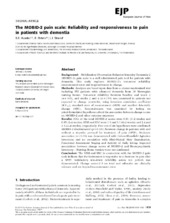| dc.contributor.author | Husebø, Bettina Sandgathe | en_US |
| dc.contributor.author | Ostelo, R. | en_US |
| dc.contributor.author | Strand, Liv Inger | en_US |
| dc.date.accessioned | 2014-12-04T10:55:42Z | |
| dc.date.available | 2014-12-04T10:55:42Z | |
| dc.date.issued | 2014-05-05 | eng |
| dc.identifier.issn | 1090-3801 | |
| dc.identifier.uri | https://hdl.handle.net/1956/8832 | |
| dc.description.abstract | Background: Mobilization-Observation-Behavior-Intensity-Dementia-2 (MOBID-2) pain scale is a staff-administered pain tool for patients with dementia. This study explores MOBID-2’s test–retest reliability, measurement error and responsiveness to change. Methods: Analyses are based upon data from a cluster randomized trial including 352 patients with advanced dementia from 18 Norwegian nursing homes. Test–retest reliability between baseline and week 2 (n = 163), and weeks 2 and 4 (n = 159) was examined in patients not expected to change (controls), using intraclass correlation coefficient (ICC2.1), standard error of measurement (SEM) and smallest detectable change (SDC). Responsiveness was examined by testing six priori-formulated hypotheses about the association between change scores on MOBID-2 and other outcome measures. Results: ICCs of the total MOBID-2 scores were 0.81 (0–2 weeks) and 0.85 (2–4 weeks). SEM and SDC were 1.9 and 3.1 (0–2 weeks) and 1.4 and 2.3 (2–4 weeks), respectively. Five out of six hypotheses were confirmed: MOBID-2 discriminated (p < 0.001) between change in patients with and without a stepwise protocol for treatment of pain (SPTP). Moderate association (r = 0.35) was demonstrated with Cohen-Mansfield Agitation Inventory, and no association with Mini-Mental State Examination, Functional Assessment Staging and Activity of Daily Living. Expected associations between change scores of MOBID-2 and Neuropsychiatric Inventory – Nursing Home version were not confirmed. Conclusion: The SEM and SDC in connection with the MOBID-2 pain scale indicate that the instrument is responsive to a decrease in pain after a SPTP. Satisfactory test–retest reliability across test periods was demonstrated. Change scores ≥ 3 on total and subscales are clinically relevant and are beyond measurement error. | en_US |
| dc.language.iso | eng | eng |
| dc.publisher | Wiley | eng |
| dc.rights | Attribution-NonCommercial-NoDerivs CC BY-NC-ND | eng |
| dc.rights.uri | http://creativecommons.org/licenses/by-nc-nd/3.0/ | eng |
| dc.title | The MOBID-2 pain scale: Reliability and responsiveness to pain in patients with dementia | en_US |
| dc.type | Peer reviewed | |
| dc.type | Journal article | |
| dc.description.version | publishedVersion | en_US |
| dc.rights.holder | Copyright 2014 The Authors | |
| dc.identifier.doi | https://doi.org/10.1002/ejp.507 | |
| dc.identifier.cristin | 1216864 | |
| dc.source.journal | European Journal of Pain | |
| dc.source.40 | 18 | |
| dc.source.14 | 10 | |
| dc.source.pagenumber | 1419-1430 | |

